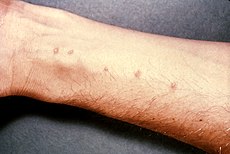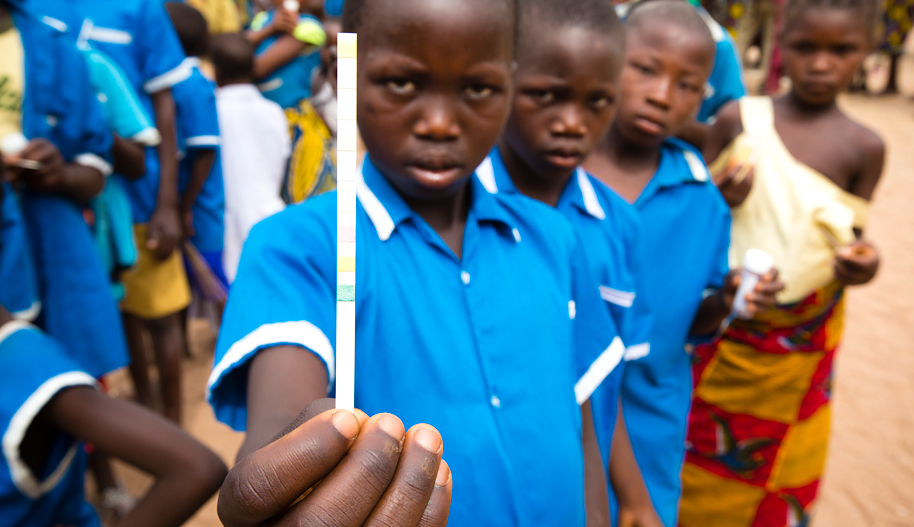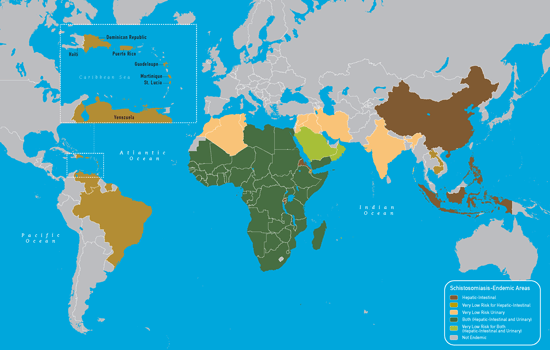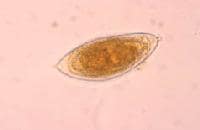Schistosomiasis /ˌʃistəsɵˈmaɪəsəs/ (also known as bilharzia, snail fever, and Katayama fever) is a disease caused by parasitic worms of the Schistosoma type. It may infect the urinary tract or intestines. Symptoms may include abdominal pain, diarrhea, bloody stool, or blood in the urine. In those who have been infected a long time, liver damage, kidney failure, infertility, or bladder cancer may occur. In children it may cause poor growth and learning difficulty.
The disease is spread by contact with water that contains the parasites. These parasites are released from freshwater snails that have been infected. The disease is especially common among children in developing countries as they are more likely to play in infected water. Other high risk groups include farmers, fishermen, and people using infected water for their daily chores. It belongs to the group of helminth infections. Diagnosis is by finding the eggs of the parasite in a person's urine or stool. It can also be confirmed by finding antibodies against the disease in the blood.
Methods to prevent the disease include improving access to clean water and reducing the number of snails. In areas where the disease is common entire groups may be treated all at once and yearly with the medication praziquantel. This is done to decrease the number of people infected and therefore decrease the spread of the disease. Praziquantel is also the treatment recommended by the World Health Organization for those who are known to be infected.
Schistosomiasis affects almost 210 million people worldwide, and an estimated 12,000 to 200,000 people die from it a year. The disease is most commonly found in Africa, as well as Asia and South America. Around 700 million people, in more than 70 countries, live in areas where the disease is common. Schistosomiasis is second only to malaria, as a parasitic disease with the greatest economic impact. From ancient times to the early 20th century, schistosomiasis' symptom of blood in the urine was seen as a male version of menstruation in Egypt and was thus viewed as a rite of passage for boys, even being linked to increased fertility. It is classified as a neglected tropical disease.
Classification

Species of Schistosoma that can infect humans:
- Schistosoma mansoni (ICD-10 B65.1) and Schistosoma intercalatum (B65.8) cause intestinal schistosomiasis
- Schistosoma haematobium (B65.0) causes urinary schistosomiasis
- Schistosoma japonicum (B65.2) and Schistosoma mekongi (B65.8) cause Asian intestinal schistosomiasis
Avian schistosomiasis species cause swimmer's itch and clam digger itch
Species of Schistosoma that can infect other animals:
S. bovis â€" normally infects cattle, sheep and goats in Africa, parts of Southern Europe and the Middle East
S. mattheei â€" normally infects cattle, sheep and goats in Central and Southern Africa
S. margrebowiei â€" normally infects antelope, buffalo and waterbuck in Southern and Central Africa
S. curassoni â€" normally infects domestic ruminants in West Africa
S. rodhaini â€" normally infects rodents and carnivores in parts of Central Africa
Signs and symptoms

Above all, schistosomiasis is a chronic disease. Many infections are subclinically symptomatic, with mild anemia and malnutrition being common in endemic areas. Acute schistosomiasis (Katayama's fever) may occur weeks after the initial infection, especially by S. mansoni and S. japonicum. Manifestations include:
- Abdominal pain
- Cough
- Diarrhea
- Eosinophilia â€" extremely high eosinophil granulocyte (white blood cell) count.
- Fever
- Fatigue
- Hepatosplenomegaly â€" the enlargement of both the liver and the spleen.
- Hepatic schistosomiasis is the second most common cause of esophageal varices worldwide.
- Genital sores â€" lesions that increase vulnerability to HIV infection. Lesions caused by schistosomiasis may continue to be a problem after control of the schistosomiasis infection itself. Early treatment, especially of children, which is relatively inexpensive, prevents formation of the sores.
- Skin symptoms: At the start of infection, mild itching and a papular dermatitis of the feet and other parts after swimming in polluted streams containing cercariae.
Occasionally central nervous system lesions occur: cerebral granulomatous disease may be caused by ectopic S. japonicum eggs in the brain, and granulomatous lesions around ectopic eggs in the spinal cord from S. mansoni and S. haematobium infections may result in a transverse myelitis with flaccid paraplegia.
Continuing infection may cause granulomatous reactions and fibrosis in the affected organs, which may result in manifestations that include:
- Colonic polyposis with bloody diarrhea (Schistosoma mansoni mostly);
- Portal hypertension with hematemesis and splenomegaly (S. mansoni, S. japonicum);
- Cystitis and ureteritis (S. haematobium) with hematuria, which can progress to bladder cancer;
- Pulmonary hypertension (S. mansoni, S. japonicum, more rarely S. haematobium);
- Glomerulonephritis;
- and central nervous system lesions.
Bladder cancer diagnosis and mortality are generally elevated in affected areas.
Pathophysiology

Life cycle
Schistosomes have a typical trematode vertebrate-invertebrate lifecycle, with humans being the definitive host. Infections by this parasitic worm is in a family of diseases known as helminthiases.
Snails
The life cycles of all five human schistosomes are broadly similar: parasite eggs are released into the environment from infected individuals, hatching on contact with fresh water to release the free-swimming miracidium. Miracidia infect freshwater snails by penetrating the snail's foot. After infection, close to the site of penetration, the miracidium transforms into a primary (mother) sporocyst. Germ cells within the primary sporocyst will then begin dividing to produce secondary (daughter) sporocysts, which migrate to the snail's hepatopancreas. Once at the hepatopancreas, germ cells within the secondary sporocyst begin to divide again, this time producing thousands of new parasites, known as cercariae, which are the larvae capable of infecting mammals.
Cercariae emerge daily from the snail host in a circadian rhythm, dependent on ambient temperature and light. Young cercariae are highly mobile, alternating between vigorous upward movement and sinking to maintain their position in the water. Cercarial activity is particularly stimulated by water turbulence, by shadows and by chemicals found on human skin.
The most common way of getting schistosomiasis in developing countries is by wading or swimming in lakes, ponds and other bodies of water that are infested with the snails (usually of the genera Biomphalaria, Bulinus, or Oncomelania) that are the natural reservoirs of the Schistosoma pathogen.
Humans
Penetration of the human skin occurs after the cercaria have attached to and explored the skin. The parasite secretes enzymes that break down the skin's protein to enable penetration of the cercarial head through the skin. As the cercaria penetrates the skin it transforms into a migrating schistosomulum stage.
The newly transformed schistosomulum may remain in the skin for two days before locating a post-capillary venule; from here the schistosomulum travels to the lungs where it undergoes further developmental changes necessary for subsequent migration to the liver. Eight to ten days after penetration of the skin, the parasite migrates to the liver sinusoids. S. japonicum migrates more quickly than S. mansoni, and usually reaches the liver within eight days of penetration. Juvenile S. mansoni and S. japonicum worms develop an oral sucker after arriving at the liver, and it is during this period that the parasite begins to feed on red blood cells. The nearly-mature worms pair, with the longer female worm residing in the gynaecophoric channel of the shorter male. Adult worms are about 10 mm long. Worm pairs of S. mansoni and S. japonicum relocate to the mesenteric or rectal veins. S. haematobium schistosomula ultimately migrate from the liver to the perivesical venous plexus of the bladder, ureters, and kidneys through the hemorrhoidal plexus.
Parasites reach maturity in six to eight weeks, at which time they begin to produce eggs. Adult S. mansoni pairs residing in the mesenteric vessels may produce up to 300 eggs per day during their reproductive lives. S. japonicum may produce up to 3,000 eggs per day. Many of the eggs pass through the walls of the blood vessels, and through the intestinal wall, to be passed out of the body in feces. S. haematobium eggs pass through the ureteral or bladder wall and into the urine. Only mature eggs are capable of crossing into the digestive tract, possibly through the release of proteolytic enzymes, but also as a function of host immune response, which fosters local tissue ulceration. Up to half the eggs released by the worm pairs become trapped in the mesenteric veins, or will be washed back into the liver, where they will become lodged. Worm pairs can live in the body for an average of four and a half years, but may persist up to twenty years.
Trapped eggs mature normally, secreting antigens that elicit a vigorous immune response. The eggs themselves do not damage the body. Rather it is the cellular infiltration resultant from the immune response that causes the pathology classically associated with schistosomiasis.
Diagnosis
Contemporary diagnosis involves detection of parasitic antigens by ELISA; all that is required from the patient is a blood sample. This screening method is highly effective. Microscopic identification of eggs in stool or, less commonly, the urine is another way of arriving at a positive diagnosis. For the measurement of eggs in the feces of presenting patients the scientific unit used is eggs per gram (epg). Stool examination should be performed when infection with S. mansoni or S. japonicum is suspected, and urine examination should be performed if S. haematobium is suspected.
Eggs can be present in the stool in infections with all Schistosoma species. The examination can be performed on a simple smear (1 to 2Â mg of fecal material). Since eggs may be passed intermittently or in small amounts, their detection will be enhanced by repeated examinations and/or concentration procedures (such as the formalin-ethyl acetate technique). In addition, for field surveys and investigational purposes, the egg output can be quantified by using the Kato technique (20 to 50Â mg of fecal material) or the Ritchie technique.
Eggs can be found in the urine in infections with S. japonicum and with S. intercalatum (recommended time for collection: between noon and 3 p.m.) Detection will be enhanced by centrifugation and examination of the sediment. Quantification is possible by using filtration through a nucleopore membrane of a standard volume of urine followed by egg counts on the membrane. Investigation of S. haematobium should also include a pelvic x-ray as bladder wall calcification is highly characteristic of chronic infection.
Recently a field evaluation of a novel handheld microscope was undertaken in Uganda for the diagnosis of intestinal schistosomiasis by a team led by Russell Stothard from the Natural History Museum of London, working with the Schistosomiasis Control Initiative, London.
Tissue biopsy (rectal biopsy for all species and biopsy of the bladder for S. haematobium) may demonstrate eggs when stool or urine examinations are negative.
The eggs of S. haematobium are ellipsoidal with a terminal spine, S. mansoni eggs are also ellipsoidal but with a lateral spine, S. japonicum eggs are spheroidal with a small knob.
Antibody detection can be useful in both clinical management and for epidemiologic surveys.
Prevention

A few countries have eradicated the disease, and many more are working toward it. The World Health Organization is promoting these efforts. In some cases, urbanization, pollution, and/or consequent destruction of snail habitat has reduced exposure, with a subsequent decrease in new infections.
Snails
Prevention is best accomplished by eliminating the water-dwelling snails that are the natural reservoir of the disease. Acrolein, copper sulfate, and niclosamide can be used for this purpose. Recent studies have suggested that snail populations can be controlled by the introduction of, or augmentation of existing, crayfish populations.
For many years from the 1950s onwards, vast dams and irrigation schemes were constructed, causing a massive rise in water-borne infections from schistosomiasis. The detailed specifications laid out in various UN documents since the 1950s could have minimized this problem. Irrigation schemes can be designed to make it hard for the snails to colonize the water, and to reduce the contact with the local population.
This has been cited as a classic case of the relevance paradox because guidelines on how to design these schemes to minimise the spread of the disease had been published years before, but the designers were unaware of them.
Treatment

Schistosomiasis is treatable using a single dose of the drug praziquantel by mouth annually.
The World Health Organization has developed guidelines for community treatment based on the impact the disease has on children in villages in which it is common:
- When a village reports more than 50 percent of children have blood in their urine, everyone in the village receives treatment.
- When 20 to 50 percent of children have bloody urine, only school-age children are treated.
- When fewer than 20 percent of children have symptoms, mass treatment is not implemented.
Other possible treatments include a combination of praziquantel with metrifonate, artesunate or mefloquine. A Cochrane review found tentative evidence that when used alone metrifonate was as effective as praziquantel.
Another agent, mefloquine, which has previously been used to treat malaria, was recognised in 2008â€"2009 to be effective against schistosoma. Mefloquine may be used in combination with praziquantel or artemisinins. Its mechanism of action is not known but it causes extensive and severe morphological, histopathological, and ultrastructural damage to adult and juvenile schistosomes, particularly, the worm tegument, musculature, gut, and vitelline glands of female worms.
Epidemiology
The disease is found in tropical countries in Africa, the Caribbean, eastern South America, Southeast Asia and in the Middle East. Schistosoma mansoni is found in parts of South America and the Caribbean, Africa, and the Middle East; Schistosoma haematobium in Africa and the Middle East; and Schistosoma japonicum in the Far East. Schistosoma mekongi and Schistosoma intercalatum are found locally in Southeast Asia and central West Africa, respectively.
The disease is common in about 75 developing countries and mainly affects people living in rural agricultural and peri-urban areas.
Infection estimates
In 2010, approximately 238Â million people were infected with schistosomiasis, 85% of whom live in Africa. An earlier estimate from 2006 had put the figure at 200 million people infected. In many of the affected areas, schistosomiasis infects a large proportion of children under 14 years of age. An estimated 600 to 700 million people worldwide are at risk from the disease because they live in countries where the organism is common. In 2012, 249 million people were in need of treatment to prevent the disease. This likely makes its the most common parasitic infection with malaria second and causing about 207 million cases in 2013.
Deaths
Estimates regarding the number of deaths vary. Worldwide in 2010 the Global Burden of Disease estimated 12,000 direct deaths while the World Health Organization (WHO) estimates more than 200,000 people die related to schistosomiasis yearly. Another 20Â million have severe consequences from the disease. It is the most deadly of the neglected tropical diseases.
History

Schistosomiasis is known as bilharzia or bilharziosis in many countries, after German physician Theodor Bilharz, who first described the cause of urinary schistosomiasis in 1851.
The first doctor who described the entire disease cycle was Brazilian parasitologist Pirajá da Silva in 1908. The first known case of infection was discovered in 2014, it belongs to a child who lived 6,200 years ago.
It was a common cause of death for Ancient Egyptians in the Greco-Roman Period.
Society and culture

Schistosomiasis is endemic in Egypt, exacerbated by the country's dam and irrigation projects along the Nile. From the late 1950s through the early 1980s, infected villagers were treated with repeated injections of tartar emetic. Epidemiological evidence suggests that this campaign unintentionally contributed to the spread of hepatitis C via unclean needles. Egypt has the world's highest hepatitis C infection rate, and the infection rates in various regions of the country closely track the timing and intensity of the anti-schistosomiasis campaign.
Schistosomiasis was mentioned in an episode of the television sitcom WKRP in Cincinnati. In the episode "Frog Story" from season 3, Dr. Johnny Fever becomes concerned that he may have schistosomiasis. Among human parasitic diseases, schistosomiasis ranks second behind malaria in terms of socio-economic and public health importance in tropical and subtropical areas.
Research

As with other major parasitic diseases, there is ongoing and extensive research into developing a schistosomiasis vaccine that will prevent the parasite from completing its life cycle in humans. In 2009, Eurogentec Biologics developed a vaccine against bilharziosis in partnership with INSERM and researchers from the Pasteur Institute.
The Bill & Melinda Gates Foundation has recently funded an operational research program â€" the Schistosomiasis Consortium for Operational Research and Evaluation (SCORE) to answer strategic questions about how to move forward with schistosomiasis control and elimination. The focus of SCORE is on development of tools and evaluation of strategies for use in mass drug administration campaigns.
Mirazid, an Egyptian drug made from myrrh, was under investigation for oral treatment of the disease up until 2005. The efficacy of praziquantel was proven to be about eight times than that of Mirazid and therefore Mirazid was not recommended as a suitable agent to control schistosomiasis.







please admin help me share this to those who still suffering of this disease. As a sign of gratitude for how my wife was saved from Schistosomiasis, i decided to reach out to those still suffering from this.
ReplyDeleteMy wife suffered Schistosomiasis in the year 2013 and it was really tough and heartbreaking for me because he was my all and the symptoms were terrible, she always complain of abdominal pain and swelling , and she always have skin itching. we tried various therapies prescribed by our neurologist but none could cure her. I searched for a cure and i saw a testimony by someone who was cured and so many other with similar body problem, and he left the contact of the doctor who had the cure to Schistosomiasis . I never imagined Schistosomiasis . has a natural cure not until i contacted him and he assured me my wife will be fine. I got the herbal medication he recommended and my wife used it and in one months time he was fully okay even up till this moment she is so full of life.Schistosomiasis . has a cure and it is a herbal cure contact the doctor for more info on drwilliams098765@gmail.com on how to get the medication. Thanks for reading my story
please admin help me share this to those who still suffering of this ailment.
ReplyDelete. As a sign of gratitude for how my wife was saved from Schistosomiasis, i decided to reach out to those still suffering from this.
My wife suffered Schistosomiasis in the year 2013 and it was really tough and heartbreaking for me because she was my all and the symptoms were terrible, she always complain of abdominal pain and swelling , and she always have skin itching. we tried various therapies prescribed by our neurologist but none could cure her. I searched for a cure and i saw a testimony by someone who was cured and so many other with similar body problem, and he left the contact of the doctor who had the cure to Schistosomiasis . I never imagined Schistosomiasis . has a natural cure not until i contacted him and he assured me my wife will be fine. I got the herbal medication he recommended and my wife used it and in one months time she was fully okay even up till this moment she is so full of life.Schistosomiasis has a cure and it is a herbal cure contact the doctor for more info on drwilliams098675@gmail.com on how to get the medication. Thanks admin for such an informative blog.
I'm 61 years old, I contracted hpv in 2011' I has be taking lot treatment for it and some months ago the wart stated coming out seriously, I used lot recommendation because there was lot warts around my anus and was so embarrassed. but today I'm totally happy I got the virus eliminated by using natural treatment from Dr Onokun herbal center after his treatment I got cured. all the warts went away' seriously believed Dr Onokun he have the cure for human papillomavirus because he has eliminated hpv been in my body since 2011, Dr Onokun make it possible for me. Here is Dr Onokun email to reach him: Dronokunherbalcure@gmail.com he is welled capable of curing terrible diseases.
ReplyDeleteHappiness is all i see now I never thought that I will live on
ReplyDeleteearth before the year runs out. I have been suffering from a
deadly disease (Herpes) for the past 3 years now; I had spent
a lot of money going from one places to another, from
churches to churches, hospitals have been my home every day
residence. Constant checks up have been my hobby not until
this faithful day, I was searching through the internet, I saw a
testimony on how pp him +2348154637647 Dr Lucky, helped
someone in curing his Herpes disease, quickly I copied his
email which is (drluckyherbalcure@gmail.com) just to give
him a test I spoke to him, he asked me to do some certain
things which I did, he told me that he is going to provide the
herbal cure to me, which he did, then he asked me to go for
medical checkup after some days after using the herbal cure, I
was free from the deadly disease, he only asked me to post
the testimony through the whole world, faithfully am doing it
now, please brothers and sisters, he is great, I owe him in
return. if you are having a similar problem just email him on
(drluckyherbalcure@gmail.com) or Call him or WhatsApp him
+2348154637647
I’m here to testify about what DR. ISIBOR did for me. I have been suffering from (GENITAL HERPES VIRUS) disease for the past 3 years and had constant pain and inching, especially in my private part. During the first year, I had faith in God that i would be cured someday.This disease started circulating all over my body and I have been taking treatment from my doctor, few weeks ago I came across a testimony of Rose Smith on the internet testifying about a Man called DR. ISIBOR on how he cured her from 7 years HSV 2. And she also gave the email address of this man, advise anybody to contact him for help on any kind of diseases that he would be of help, so I emailed him telling him about my (HSV 2) he told me not to worry that I was going to be cured!! Well, I never doubted him I have faith he can cure me too,, DR. ISIBOR prepared and sent me Healing Oil, Soap, roots and herbs which I took. In the first one week, I started experiencing changes all over me, after four weeks of using his Roots/ Herbs, Oil and Soap, I was totally cured. no more inching , pain on me anymore as DR. ISIBOR assured me. After some time I went to my doctor to do another test behold the result came out negative. So friends my advise is if you have such disease or know anyone who suffers from it or any other disease like HPV, HIV, ALS, CANCER etc. you can contact DR. ISIBOR for help via email} drisiborspellhome@gmail.com or call +2348107855231
ReplyDeleteCan't still believe that i got cured from Genital Herpes through herbal treatment from Dr LUCKY who I met through the internet, I actually couldn't believe it at first because it sounded impossible to me knowing how far I have gone just to get rid of it. Dr LUCKY send me his medicine which I took as instructed and here I am living a happy life once again, a big thanks to Dr LUCKY , I am sure there are many herbal doctors out there but Dr LUCKY did it for me, contact him on Email him; { drluckyherbalcure@gmail.com }
ReplyDeleteI’m here to testify about what DR. ISIBOR did for me. I have been suffering from (GENITAL HERPES VIRUS) disease for the past 3 years and had constant pain and inching, especially in my private part. During the first year, I had faith in God that i would be cured someday.This disease started circulating all over my body and I have been taking treatment from my doctor, few weeks ago I came across a testimony of Rose Smith on the internet testifying about a Man called DR. ISIBOR on how he cured her from 7 years HSV 2. And she also gave the email address of this man, advise anybody to contact him for help on any kind of diseases that he would be of help, so I emailed him telling him about my (HSV 2) he told me not to worry that I was going to be cured!! Well, I never doubted him I have faith he can cure me too,, DR. ISIBOR prepared and sent me Healing Oil, Soap, roots and herbs which I took. In the first one week, I started experiencing changes all over me, after four weeks of using his Roots/ Herbs, Oil and Soap, I was totally cured. no more inching , pain on me anymore as DR. ISIBOR assured me. After some time I went to my doctor to do another test behold the result came out negative. So friends my advise is if you have such disease or know anyone who suffers from it or any other disease like HPV, HIV, ALS, CANCER etc. you can contact DR. ISIBOR for help via email} {drisiborspellhome@gmail.com} you can also contact him on WhatsApp +2348107855231
ReplyDeleteHello everybody, I just want to give this great testimony to the whole public about a great man who helped me out of a serious illness. I have had HSV-1 AND HSV-2 VIRUS for good 2 years now and I was almost going to the end of my life due to the illness. All I have in my mind is, let me just give up because life is not interesting for me any longer and i also pray that God should accept my soul when ever I’m gone luckily for me, my kid sister run to me that she found a doctor in the INTERNET who can cure HSV-1 AND HSV-2 VIRUS. She helped me out with everything, the man asked for my details so he can prepare herbal medicine for me. After he was done consulting on my details he told me how my medicine will be prepare, after he was done preparing my medicine he sent me my medication and after using it for 7 days i later started noticing something different in my blood so I went for my HSV-1 AND HSV-2 VIRUS test and I was tested Negative, I’m so happy that I can say I’m not patient of HSV-1 AND HSV-2 anymore. If you have HSV-1 AND HSV-2 or any sickness,HIV/AID,HPV,CANCER,HEPATITS B DIABETITS ALS,PENIS ENLARGEMNT please for your safety, contact DR.HAZIM VIA email address (usmandrhazim@gmail.com) or whats APP number +2349058026857
ReplyDelete5 years ago I had warts, I was treated with some liquid applied to the warts they continued to grow and spread... The next 2 doctors did laser surgery to remove them. 1 year after the surgery, they grew back close to where the 1st ones were' so I was finally told it was hpv. I have had it for very long time, I contract it from my cheated boyfriend and I found out he was also infected and I end up the relationship between us. the warts was so embarrasses because it started spreading all over I have be dealing with this things for very long time the last treatment I take was About 2 years ago I applied natural treatment from Dr onokun herbal cure, a week after applying the treatment all the warts was gone. it's now 2 years and some months I don't have single wart or any symptoms of hpv. wow"" it's great, Dr onokun has finally cured me. Anyone living with hpv contact Dr onokun for natural treatment.
ReplyDeleteHis email address: Dronokunherbalcure@gmail.com
Traditional Herbal doctor Omolade Cure HSV-2 Disease I want to thank Dr omolade for helping me with his Herbal Medicine that cure my HSV-2 Disease completely.i have been living with HSV-2 Disease for the past 3yrs. i was so happy when i found Dr omolade blogs: how Dr omolade help people in the world to cure HSV, with Herbal Medicine he Cured My HSV -2 Negative after using the Herbal Medicine Dr Omolade sent to me. I give thanks to God and healed completely. you are the best Traditional Herbal doctor in the world Dr Omolade visit his website for more information https://dr-omolade-herbal-centre.business.site/?m=true or @ dromoladeherbalcenter@gmail.com
ReplyDeleteherpes is a serious and recurring disease which can't be cured through drugs or injections by the American doctors but the best way to deal with herpes is by taking natural herbs medicine for it and is only few American doctors that know about this herbal medicine from Dr Akhanene .. I have read about Dr Akhanene the great herbalist doctor from African who can cure disease with his powerful herbal medicine. for the people suffering from the following diseases, Herpes, Cancer, Also,Herpatitis, Diabetes, Hps,Infections ETC should contact him for his herbal medicine because i am a living testimony and i was cured of herpes. Although, i sent him what he requested and he sent me his medicine which i took for 1 weeks and today when i went for test i was tested herpes negative. you can reach him through his Emai drakhanenespellhome@gmail.com.com or whatsapp or call him +2348168714427
ReplyDeleteI'm very excited to inform everyone that I'm completely cured from my HPV recently. I used Dr Onokun herbal medicine, it's really help during my outbreaks but I totally got cured! from my HPV with a strong and active herbal medicine ordered from a powerful herbalist Dr onokun Contact him via CAll/Whats app +1 208 425 7799 or visit his Facebook page: https://www.facebook.com/naturaltreatmentcenter1
ReplyDelete